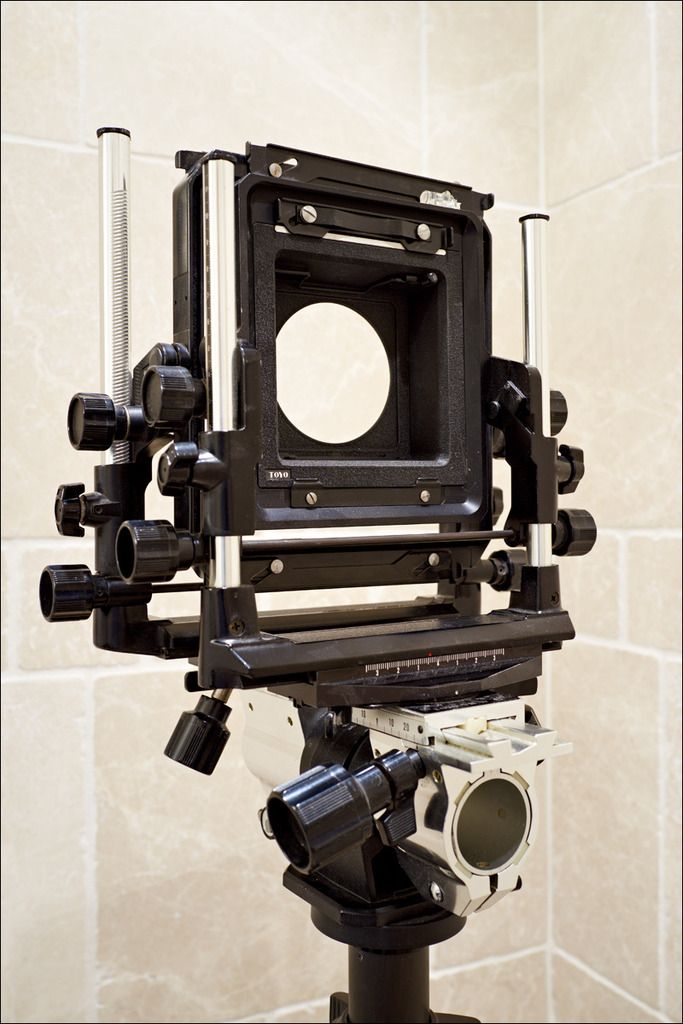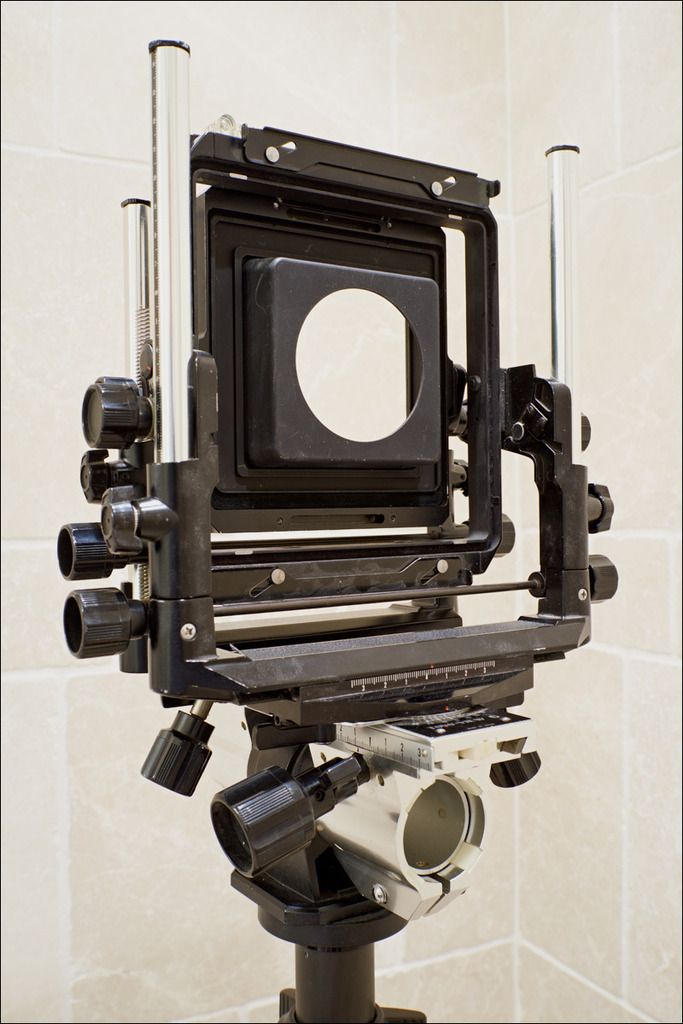It's not clear what sort of budget you have in mind, but assuming you mean the type of budget that has you buying bits and pieces and cobbling together over time something that will work (as your initial post suggests) rather than buying a complete 6x9 / 2x3 view camera setup, then the answer is clearly Toyo, which made cameras in many formats over the years and all of which are quite modular, which makes swapping parts around between them fairly easy.
In fact, I have done exactly what you propose, combining parts from a Toyo 45G and 23G, plus various accessories (and as shown in these photos, with 810G standard platforms, which are considerably larger than the 45G and 23G platforms, but also provide more stability), to come up with a Frankencamera that was assembled specifically for the purpose of using wide-angle lenses. Behold:
As you can see in the photos below, when moved all the way to its rearmost position, the recessed lensboard on the front standard will actually next inside the rear standard and with many lenses, this will cause the rear element to very close to, if not into contact with, the groundglass. I am not aware of any other commercially made view camera that has this capability:
FYI, there is actually another lensboard adapter combo that will nest even further inside the rear standard, but it leaves very little room to operate the shutter and adjust the lens aperture, so I didn't use it unless I absolutely had no choice.
Note that with the bag bellows attached, the two standards can't be moved quite this closely together, because a small amount of room -- maybe 8-10 mm -- must be allowed for the two thicknesses of bellows material to slide over themselves as movements are applied.
Note also that while every part I used (including several not shown here, which are used to configure the camera differently for other applications) was made by Toyo, some of them will need to be modified in minor ways. But what needs doing will be obvious and easy for any home hobbyist to either do themselves or arrange to have done by a machinist.
The only tricky issue is with the sliding back adapter, because it can only be mounted vertically, as the uprights of the rear standard will interfere with its movement side-to-side. I used a no-name Chinese-made one sourced via eBay, but once I exchanged the crappy groundglass with a spare Toyo one I had (which had to be trimmed and shimmed to fit and align properly) it worked very well. Alas, this was often not as well as I wanted or needed, because it was very difficult to zero the movements for shots where they weren't needed, so I was almost always applying a small amount of tilt or swing and while this wasn't visible when the camera was used with film, it did become visible at times when used with even a modest digital back (which in my case was a Phase One P30+ and definitely a sub-optimal choice because its design restricted the amount of movements that could be used with typical view camera lenses before vignetting occurred.)
Unfortunately, trying to follow in my footsteps will be difficult, because Toyo 23G cameras were not made in very large numbers (I understand the production total was just over 100 copies and that was nearly 30 years ago, so good luck finding one today) and the same is also true for some of the accessories I used (for example, the bag bellows that works with a 45G standard on one side and a 23G standard on the other side.) That said, you can also accomplish much the same end result using a pair of 45G standards and this will make it easier to find a bag bellows as well, but the camera will be bulkier and heavier, too, so ultimately less useful for field work, if that's your thing. Alternatively, you might get lucky and find a Toyo VX 23D being sold inexpensively -- I saw one sell for ~$1,400 on eBay a few years ago, but passed on it because I didn't have any significant use for it at the time -- or perhaps another brand/model of 6x9/2x3 view camera that were available for a short time a decade or so ago.
As the dust on the camera suggests, I haven't used this setup in many years and the only reason I've held onto it was because I don't know what the future might bring and trying to duplicate it would be very difficult, if not impossible, as I noted above. I no longer have the sliding back adapter because I let a friend borrow it and he's since moved away and we've lost touch, so I no idea where it is now. But I don't expect replacing it will prove to be an insurmountable obstacle.
That said, though, I may be persuaded to part with it, so if you're interested, send me a PM and we can discuss it.



